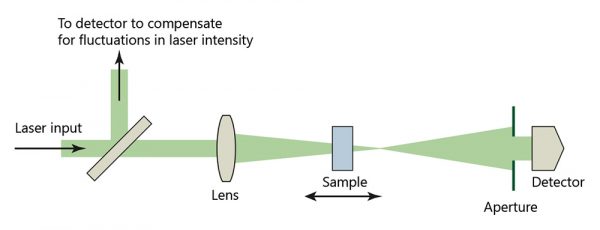 Z-scan operating principle
Z-scan operating principleIn nonlinear optics, z-scan technique is used to measure the non-linear index n2 (Kerr nonlinearity) and the non-linear absorption coefficient Δα via the “closed” and “open” methods to measure both real and imaginary components of the nonlinear refractive index.
For measuring the real part of the nonlinear refractive index, the z-scan setup is used in its closed-aperture form. The sample is typically placed in the focal plane of the lens, and then moved along the z axis, defined by the Rayleigh length. In this form, since the nonlinear material reacts like a weak z-dependent lens, the far-field aperture makes it possible to detect small beam distortions in the original beam. Since the focusing power of this weak nonlinear lens depends on the nonlinear refractive index, it is possible to extract its value by analyzing the z-dependent data acquired by the detector and by interpreting them using an appropriate theory.
For measurements of the imaginary part of the nonlinear refractive index, or the nonlinear absorption coefficient, the z-scan setup is used in its open-aperture form. In open-aperture measurements, the far-field aperture is removed and the whole signal is measured by the detector. By measuring the whole signal, the beam small distortions become insignificant and the z-dependent signal variation is due to the nonlinear absorption entirely.
The main cause of non-linear absorption is two-photon absorption. Due to high pulse intensity and cost effectiveness, picosecond high energy lasers are the most appropriate choice for z-scan measurements.
